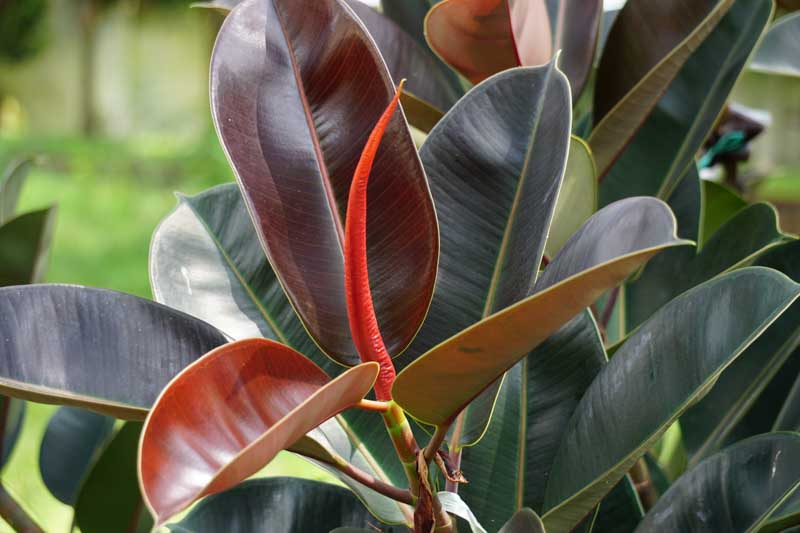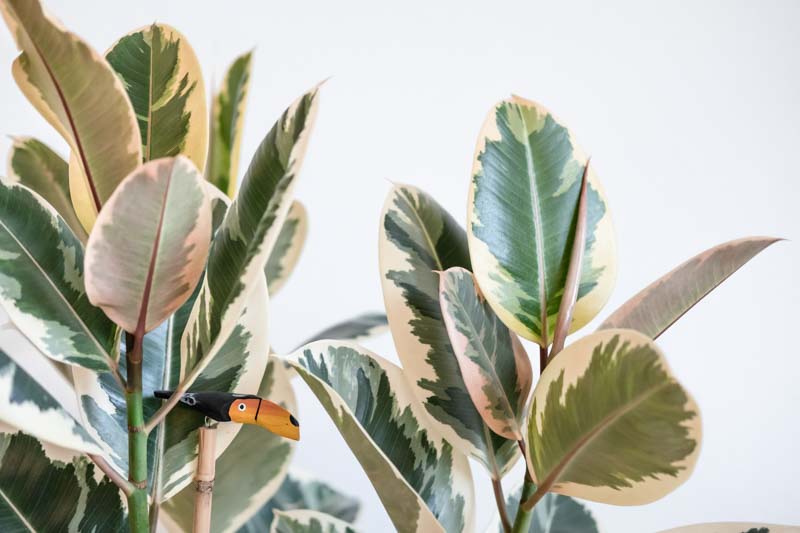Rubber Tree, Rubber Plant, Assam Rubber, Caoutchouc, India Rubber Fig, India Rubber Plant, India Rubber Tree, Snake Tree
Ficus elastica, commonly known as the Rubber Plant or Rubber Tree, is a popular houseplant in temperate climates, prized for its glossy, dark green leaves and robust growth.
Native: The Rubber Tree is native to Southeast Asia, particularly India, Nepal, Bhutan, Burma, Malaysia, and Indonesia. It belongs to the mulberry and fig family Moraceae.
Plant Type and Habit: This fig species is a tropical evergreen tree. In its natural habitat, it exhibits an upright, branching growth habit.
Size: Ficus elastica is a substantial tree that can grow up to 100 feet tall in its natural environment. It belongs to the banyan figs group and forms aerial and buttressing roots for stability in the soil and to support its hefty branches. However, as a houseplant, it usually grows 6-10 feet tall (180-300 cm) with a spread of 2-3 feet (60-90 cm).
Flowers: The Rubber Tree produces small, inconspicuous flowers rarely seen on indoor plants. It also bears clusters of small yellow figs rarely seen on indoor plants.
Foliage: The most striking feature of the Rubber Tree is its glossy, leathery, dark green leaves that can grow up to 12-18 inches (30-45 cm) long. Each leaf emerges from a reddish sheath, adding a decorative touch. This striking leaf display makes it a favored choice for enhancing indoor spaces.
Bark: The bark is smooth and light gray in young trees, becoming more textured with age.
Uses: Primarily used as an ornamental indoor plant. Its sap was once used to make rubber, but this is not commercially viable compared to other species.
Award: Recipient of the prestigious Award of Garden Merit of the Royal Horticultural Society.
Hardiness: It thrives in USDA hardiness zones 10-12 and is not frost-tolerant.
Toxicity: The Rubber Tree contains a sap that is toxic to pets and humans when ingested. The sap irritates the mouth and stomach. Contact with its sap can also lead to skin irritation for some individuals.
Drought: It is fairly drought-tolerant once established.
Invasiveness: In some tropical areas outside its native range, it can become invasive. It has been reported as invasive in Papua New Guinea, New Caledonia, Singapore, southeastern Australia, and offshore Chile
Benefits: Like many houseplants, it’s an excellent air purifier, removing toxins such as formaldehyde from indoor environments.

Each leaf emerges from a reddish sheath, adding a decorative touch
Caring for Ficus elastica indoors involves several key practices to ensure its health and vigor:
Lighting: Ficus elastica prefers bright, indirect light. Too much direct sunlight can scorch the leaves, while too little light can cause leggy growth. A spot near a window with sheer curtains or an east-facing window is ideal.
Watering: Water when the top inch of soil becomes dry. Overwatering can lead to root rot, so ensure good drainage. Reduce watering in the winter when the plant’s growth slows down.
Temperature and Humidity: Maintain indoor temperatures between 60-75°F (15-24°C). Avoid placing the plant in drafty areas or near air conditioning vents. It thrives in average to high humidity. If your home is dry, especially in winter, consider using a humidifier or placing the pot on a pebble tray with water.
Soil and Repotting: Use a well-draining potting mix, ideally one designed for houseplants. Topdress annually and repot every few years to refresh the soil and provide more room for growth. Choose a pot that’s slightly larger than the current one.
Fertilizing: Feed with a high-nitrogen fertilizer every month during the growing season (spring and summer). Do not fertilize in the fall and winter.
Pruning and Cleaning: Prune in spring to maintain size and shape. Always use clean, sharp scissors or pruners. Wipe the leaves regularly with a damp cloth to remove dust and maintain their glossy appearance.
Propagation: Propagate by semi-hardwood cuttings or by air layering.

Variegated Rubber Tree: Ficus elastica ‘Tineke’
Caring for a Rubber Tree outdoors requires attention to several key factors, especially if you are in a climate that differs from its native tropical habitat:
Climate Suitability: Ficus elastica thrives in USDA hardiness zones 10-12. It’s not frost-tolerant and should be grown outdoors only in warm, humid climates. In cooler zones, it can be placed outside during summer but must be brought indoors before temperatures drop in the fall.
Sunlight: When grown outdoors, it prefers a location with bright, indirect sunlight. Direct, harsh sunlight can scorch the leaves. A spot with morning sun and afternoon shade is often ideal.
Watering: Water the tree when the top inch of the soil feels dry. Outdoor plants may require more frequent watering, especially in hot, dry weather. Ensure the planting site has good drainage to prevent waterlogging.
Soil: Plant in well-draining soil. If necessary, amend the soil with organic matter to improve drainage and nutrient content.
Temperature: Ideal temperatures are between 60-85°F (15-29°C). Protect the tree from temperatures below 50°F (10°C).
Fertilizing: Fertilize with a balanced, slow-release fertilizer in the spring and summer. Reduce feeding in the fall and stop in the winter.
Pruning: Prune to shape the tree and remove any damaged or diseased branches. Pruning is best done in the spring.
Mulching: Apply a layer of mulch around the base to retain soil moisture and regulate temperature.
Winter Care: In areas with mild winters, provide extra mulch for root protection. In colder zones, the Rubber Tree should be grown in a pot and brought indoors for the winter.
The Rubber Tree is generally a robust and low-maintenance plant, but like all plants, it can encounter certain pests, diseases, and common problems, especially when grown indoors.
Aphids: They are small, sap-sucking insects, often green or black, which cluster on new growth and undersides of leaves. They excrete sticky honeydew, leading to sooty mold. Treatment includes washing them off with water or using insecticidal soap.
Spider mites: These tiny pests can cause yellowing or speckling on leaves. You may also see fine webs. Increase humidity around the plant and wipe the leaves with a damp cloth. If infestation persists, use insecticidal soap or neem oil.
Mealybugs: These small, white, cottony pests suck sap from the leaves, weakening the plant. They can be removed with a cotton swab dipped in rubbing alcohol or treated with insecticidal soap.
Scale insects: These look like small, brown, bumpy spots on stems and leaves. They can be scraped off gently or treated with neem oil or insecticidal soap.
Root rot: Overwatering can lead to root rot, a serious condition that can kill the plant. Signs include yellowing leaves, wilting, and a musty smell from the soil. Prevent it by ensuring proper drainage and allowing the soil to dry between waterings.
Leaf spot: This can be caused by either fungal or bacterial infections, leading to brown or black spots on the leaves. Improve air circulation, avoid wetting the leaves, and remove affected leaves. Fungicide or bactericide may be needed in severe cases.
Gray mold or botrytis: A fungal disease that causes gray mold on leaves, especially in cool, damp conditions. Improve air circulation, reduce humidity, and remove affected parts. Fungicides can be used for severe infections, and preventive care is crucial.
Drooping Leaves: Can be a sign of both overwatering and underwatering.
Yellowing Leaves: Often a symptom of overwatering, poor drainage, or insufficient light.
Leaf Drop: Sudden changes in temperature, light, or transplant shock can cause leaves to fall off.
Lack of Humidity: Low humidity can lead to brown leaf tips or edges.
In its native environment, where it can grow to its full size, Ficus elastica (Rubber Plant) can develop extensive root systems that might be considered invasive, potentially damaging nearby structures or plumbing systems. However, when grown as an indoor plant or in a container, its root system is constrained and managed, reducing the risk of invasiveness.
Ficus elastica is generally considered good, especially as an indoor plant. It is known for its air-purifying qualities, removing toxins like formaldehyde from the air. Its large, glossy leaves also add aesthetic value to indoor spaces. The only downside might be its potential invasiveness in outdoor settings in non-native areas and its toxicity to pets and humans if ingested.
As indoor plants, rubber plants don’t spread in the sense of invasive growth. They grow upright and can become quite tall, but their spread is usually limited to the size of their container and pruning practices. In their natural habitat, they can grow quite large and wide, but this is typically not a concern for indoor or container-grown plants.
| Hardiness |
10 - 12 |
|---|---|
| Heat Zones |
10 - 12 |
| Climate Zones | 13, 16, 17, 19, 20, 21, 22, 23, 24, H1, H2 |
| Plant Type | Houseplants, Trees |
| Plant Family | Moraceae |
| Genus | Ficus |
| Common names | Rubber Tree |
| Exposure | Full Sun, Partial Sun |
| Season of Interest |
Spring (Early, Mid, Late) Summer (Early, Mid, Late) Fall Winter |
| Height |
6' - 100' (180cm - 30.5m) |
| Spread |
2' - 100' (60cm - 30.5m) |
| Maintenance | Low |
| Water Needs | Average |
| Soil Type | Loam |
| Soil pH | Acid, Alkaline, Neutral |
| Soil Drainage | Moist but Well-Drained |
| Characteristics | Plant of Merit, Showy, Evergreen |
| Tolerance | Drought |
| Garden Uses | Beds And Borders, Patio And Containers |
| Garden Styles | Mediterranean Garden |
| Hardiness |
10 - 12 |
|---|---|
| Heat Zones |
10 - 12 |
| Climate Zones | 13, 16, 17, 19, 20, 21, 22, 23, 24, H1, H2 |
| Plant Type | Houseplants, Trees |
| Plant Family | Moraceae |
| Genus | Ficus |
| Common names | Rubber Tree |
| Exposure | Full Sun, Partial Sun |
| Season of Interest |
Spring (Early, Mid, Late) Summer (Early, Mid, Late) Fall Winter |
| Height |
6' - 100' (180cm - 30.5m) |
| Spread |
2' - 100' (60cm - 30.5m) |
| Maintenance | Low |
| Water Needs | Average |
| Soil Type | Loam |
| Soil pH | Acid, Alkaline, Neutral |
| Soil Drainage | Moist but Well-Drained |
| Characteristics | Plant of Merit, Showy, Evergreen |
| Tolerance | Drought |
| Garden Uses | Beds And Borders, Patio And Containers |
| Garden Styles | Mediterranean Garden |
How many Ficus elastica (Rubber Tree) do I need for my garden?
| Plant | Quantity | |
|---|---|---|
| Ficus elastica (Rubber Tree) | N/A | Buy Plants |
Create a membership account to save your garden designs and to view them on any device.
Becoming a contributing member of Gardenia is easy and can be done in just a few minutes. If you provide us with your name, email address and the payment of a modest $25 annual membership fee, you will become a full member, enabling you to design and save up to 25 of your garden design ideas.
Join now and start creating your dream garden!
Create a membership account to save your garden designs and to view them on any device.
Becoming a contributing member of Gardenia is easy and can be done in just a few minutes. If you provide us with your name, email address and the payment of a modest $25 annual membership fee, you will become a full member, enabling you to design and save up to 25 of your garden design ideas.
Join now and start creating your dream garden!